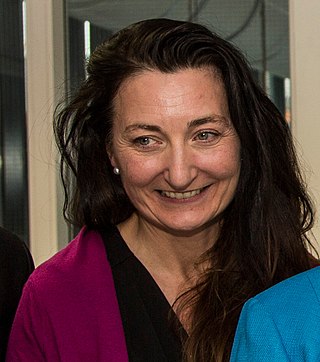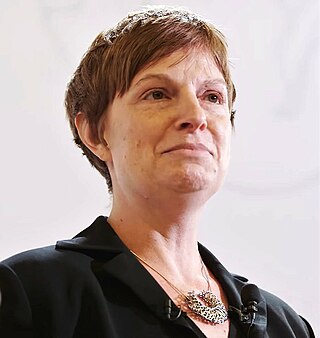
Eric Richard Kandel is an Austrian-born American medical doctor who specialized in psychiatry, a neuroscientist and a professor of biochemistry and biophysics at the College of Physicians and Surgeons at Columbia University. He was a recipient of the 2000 Nobel Prize in Physiology or Medicine for his research on the physiological basis of memory storage in neurons. He shared the prize with Arvid Carlsson and Paul Greengard.

Benjamin Anthony "Ben" Barres was an American neurobiologist at Stanford University. His research focused on the interaction between neurons and glial cells in the nervous system. Beginning in 2008, he was chair of the Neurobiology Department at Stanford University School of Medicine. He transitioned to male in 1997, and became the first openly transgender scientist in the National Academy of Sciences in 2013.
Anirvan Ghosh is an American neuroscientist and Biotech executive.

Catherine Dulac is a French–American biologist. She is the Higgins Professor in Molecular and Cellular Biology at Harvard University, where she served as department chair from 2007 to 2013. She is also an investigator at the Howard Hughes Medical Institute. She was born in 1963 in France. She came to the United States for her postdoctoral study in 1991.
Michael Greenberg is an American neuroscientist who specializes in molecular neurobiology. He served as the Chair of the Department of Neurobiology at Harvard Medical School from 2008 to 2022.
Rachel Wilson is an American professor of neurobiology at Harvard Medical School and is a Howard Hughes Medical Institute Investigator. Wilson's work integrates electrophysiology, neuropharmacology, molecular genetics, functional anatomy, and behavior to explore how neural circuits are organized to react and sense a complex environment.

Edvard Ingjald Moser is a Norwegian psychologist and neuroscientist, who is a professor at the Norwegian University of Science and Technology (NTNU) in Trondheim. In 2005, he and his then-wife May-Britt Moser discovered grid cells in the brain's medial entorhinal cortex. Grid cells are specialized neurons that provide the brain with a coordinate system and a metric for space. In 2018, he discovered a neural network that expresses a person's sense of time in experiences and memories located in the brain's lateral entorhinal cortex.

May-Britt Moser is a Norwegian psychologist and neuroscientist, who is a Professor of Psychology and Neuroscience at the Norwegian University of Science and Technology (NTNU). She and her former husband, Edvard Moser, shared half of the 2014 Nobel Prize in Physiology or Medicine, awarded for work concerning the grid cells in the entorhinal cortex, as well as several additional space-representing cell types in the same circuit that make up the positioning system in the brain. Together with Edvard Moser she established the Moser research environment at NTNU, which they lead. Since 2012 she has headed the Centre for Neural Computation.
Lu Chen is a Chinese-born American neuroscientist, who is a Professor of Neurosurgery, and of Psychiatry and Behavioral Sciences at Stanford University, and is a member of the Stanford Neurosciences Institute. She was previously an Associate Professor of Neurobiology and a member of the Helen Wills Neuroscience Institute at the University of California, Berkeley.
Christine Elizabeth Holt FRS, FMedSci is a British developmental neuroscientist.

Robert C. Malenka is a Nancy Friend Pritzker Professor in Psychiatry and Behavioral Sciences at Stanford University. He is also the director of the Nancy Friend Pritzker Laboratory in the Stanford Medical Center. He is a member of the National Academies of Sciences, Engineering, and Medicine, as well as the American Academy of Arts and Sciences. Malenka's laboratory research with the National Alzheimer's Foundation has informed researchers aiming to find a neuronal basis for Alzheimer's disease. Malenka's main career is focused on studying the mechanisms of synaptic plasticity and the effects of neural circuits on learning and memory.

Eunjoon Kim is a professor of KAIST and director of Center for Synaptic Brain Dysfunctions within the Institute for Basic Science (IBS). His current research focuses on molecular mechanisms underlying autism spectrum disorders and synaptic brain dysfunctions. With over 200 publications to his name, his research has been cited over 27,000 times giving him an h-index of 81. He graduated from Busan National University in 1986, received master's degree at KAIST in 1988, received PhD degree at Michigan State University in 1994, and worked at Harvard Medical School as a postdoctoral fellow during 1995-1996. His current research focuses on molecular organization of neuronal synapses and synapse dysfunction-related psychiatric disorders.
Laurence Frederick Abbott is an American theoretical neuroscientist, who is currently the William Bloor Professor of Theoretical Neuroscience at Columbia University, where he helped create the Center for Theoretical Neuroscience. He is widely regarded as one of the leaders of theoretical neuroscience, and is coauthor, along with Peter Dayan, on the first comprehensive textbook on theoretical neuroscience, which is considered to be the standard text for students and researchers entering theoretical neuroscience. He helped invent the dynamic clamp method alongside Eve Marder.

The Department of Neurobiology at Harvard Medical School is located in the Longwood Medical Area of Boston, MA. It is consistently ranked as one of the top programs in Neurobiology and behavior in the world. The Department is part of the Basic Research Program at Harvard Medical School, with research pertaining to development of the nervous system, sensory neuroscience, neurophysiology, and behavior. The Department was founded by Stephen W. Kuffler in 1966, the first department dedicated to Neurobiology in the world. The mission of the Department is “to understand the workings of the brain through basic research and to use that knowledge to work toward preventive and therapeutic methods that alleviate neurological diseases”.
Erin Margaret Schuman, born May 15, 1963, in California, US, is a neurobiologist who studies neuronal synapses. She is currently a Director at the Max Planck Institute for Brain Research.
HollisT. Cline is an American neuroscientist and the Director of the Dorris Neuroscience Center at the Scripps Research Institute in California. Her research focuses on the impact of sensory experience on brain development and plasticity.

Megan Carey is a neuroscientist and Group Leader of the Neural Circuits and Behavior Laboratory at the Champalimaud Centre for the Unknown in Lisbon, Portugal. She is known for her work on how the cerebellum controls coordinated movement.
Marla Beth Feller is the Paul Licht Distinguished Professor in Biological Sciences and Member of the Helen Wills Neuroscience Institute at the University of California, Berkeley. She studies the mechanisms that underpin the assembly of neural circuits during development. Feller is a Fellow of the American Association for the Advancement of Science, member of the American Academy of Arts and Sciences and member of the National Academy of Sciences.
Rachel Wong is an American neuroscientist who is a professor of Biological Structure at the University of Washington. She studies the developmental mechanisms that determine synaptic connectivity in the central nervous system. She was elected to the National Vision Research Institute of Australia in 2018 and the National Academy of Sciences in 2021.

Lisa Boulanger is an American neuroscientist and who is a professor at Princeton University. Her research considers immune proteins in the formation and function of neuronal connectivity.










